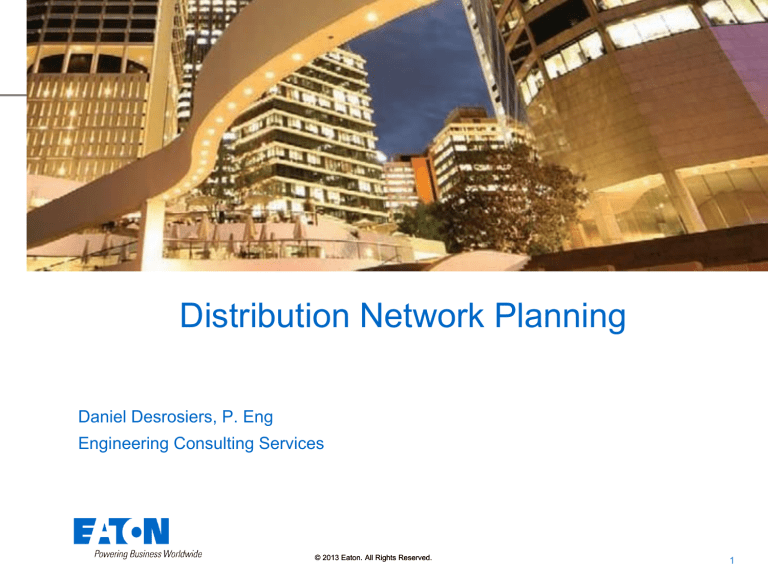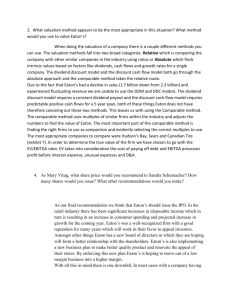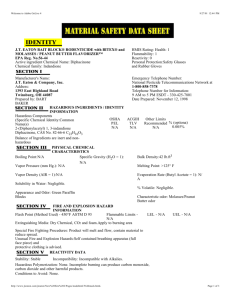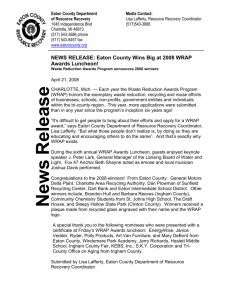Planning

Distribution Network Planning
Daniel Desrosiers, P. Eng
Engineering Consulting Services
1
What is Planning?
• Planning (also called forethought ) is the process of thinking about and organizing the activities required to achieve a desired goal.
• Planning involves the creation and maintenance of a plan . As such, planning is a fundamental property of intelligent behavior . This thought process is essential to the creation and refinement of a plan , or integration of it with other plans; that is, it combines forecasting of developments with the preparation of scenarios of how to react to them.
From Wikipedia, the free encyclopedia
© 2013 Eaton. All Rights Reserved.
2
Network Planning Goals
•
Reach all consumers wanting to be connected.
•
Meet their demand.
•
Provide satisfactory power supply reliability.
•
Provide power supply quality.
© 2013 Eaton. All Rights Reserved.
3
Planning and Forecast
• An important, albeit often ignored aspect of planning, is the relationship it holds with forecasting. Forecasting can be described as predicting what the future will look like, whereas planning predicts what the future should look like.
[1] The counterpart to planning is spontaneous order .
From Wikipedia, the free encyclopedia
© 2013 Eaton. All Rights Reserved.
4
Planning Overview
The evolution of a distribution power system comprises a number of stages of development
Although capacity, security and quality/efficiency of supply are of concern throughout the development of a system, the focus shifts over time.
In the early stages of rapid load growth or reconstruction, the priority is to build sufficient capacity to meet the load demands.
Following establishment of the network and loads, security of supply becomes a critical factor.
Once the system has matured, the focus is on optimization in terms of supply quality and efficiency.
© 2013 Eaton. All Rights Reserved.
5 5
The Environment
S TRATEGIC P LANNING
S UBTRANSMISSION
N ETWORK
G ENERATION
C APACITY
R ENEWABLE AND
ALTERNATIVE ENERGY
SOLUTIONS
D ISTRIBUTION
N ETWORK P LANNING
C ITY /T OWN P LANNING
L OAD F ORECASTING
C USTOMER C ONNECTIONS
J OIN WORKING WITH
OTHER UTILITIES
N ETWORK O PERATIONS
& S YSTEM DESIGN
A SSETS MANAGEMENT
AND C APITAL / RESOURCES
© 2013 Eaton. All Rights Reserved.
P LANNING
P ROTECTION , R ELIABILITY
AND Q UALITY OF SUPPLY
6
High Level Planning Process
© 2013 Eaton. All Rights Reserved.
7
Network Analysis Part
Start
Introduce new loads, Apply
Load growth
Get Reference network
YEAR n
Yearly T&D
Scheduled
Projects and
Improvements for YEAR n+1
Obtain New Yearly
Network Model
Run
Simulations
Update future yearly projects list
Increment YEAR counter
No
>Last
Year
© 2013 Eaton. All Rights Reserved.
Yes
Review and optimize projects plan
Identify and validate solutions
No
All ok?
Yes
Network becomes the Reference network for year n+1
The
End
8
Finding Solutions
Network
Solutions
Risk
Assessment
Identify and validate solutions
Technical and financial
Compare
Solutions
Non-Network
Solutions
Preliminary
$ Estimate
Recommendation
Update Projects list
© 2013 Eaton. All Rights Reserved.
9
Why use modern power system tools?
• Although most network planning related calculations could be done by hand, doing so will limit the number of studied solutions
• Using modern power system analysis tools makes it easy to create multiple project scenarios thus increasing planning quality
• Single data entry + Automation of data integration from multiple sources
• Territory or sub network approach allowing quick check of the entire network performance
© 2013 Eaton. All Rights Reserved.
10
Modern Power System Software is to planning what spreadsheet software was to accounting in the 80’
A wise man at Cooper/Cyme
© 2013 Eaton. All Rights Reserved.
11
Power System Analysis Tools
What should we look for :
• It should be flexible allowing variable focus for the studies
• It should allow easy integration of forecast
• Provide on demand recalculation
• Answer questions, support decisions
• Complete: take into consideration all the environment and integrate various data sources
© 2013 Eaton. All Rights Reserved.
12
Keeping up with the network!
Analysis
Load Flow
Load Allocation
Load Balancing
Load Flow with Profile
Network Forecaster
Fault Analysis
Capacitor Placement
Protective Device coordination
Load Flow Contingency
Voltage Stability - PV Approach
Single contingency Resoration
Service Restoration
Switching Optimization
Arc Flash Hazards
Volt/Var Optimization
Long Term Dynamic
Reliability Assessment
Harmonic
Transient Stability
Optimal Power Flow
Motor Start
Safety
Load
Focus
Quality /
Time Capacity Security
Efficiency
© 2013 Eaton. All Rights Reserved.
13
Environment – Network Connection
- ESRI ArcGIS 9.x
- Smallworld 3.3, 4.x
- Intergraph G/Technology 9.4
- LoadStar
- PI-Historian
- WireVision
- AMR
- etc.
- DMS
- OMS
- SCADA
- Maximo
- etc.
GIS
Geographic, Connectivity,
Settings
Customer
Information
Loads, consumption, demands
Enterprise
Systems
Settings, events history
CYMDIST Gateway
CYMDIST
Network
Model
- Oracle 9, 10, 11
- SQL Server 2000, 2005, 2008
- MS Access 2000/2003
- Self-Contained Study (XML)
© 2013 Eaton. All Rights Reserved.
14
Study case 1: PF correction
Problem: Reducing losses associated with poor PF at feeder level.
Analysis used: Optimal capacitor placement
PF
80%
90%
95%
MW
2298
2298
2298
MVA
2873
2553
2419
MVARS
(deficit)
1724
1113
755 new Mvars
(capacitors)
Potential savings
$M (see note)
611
968
$
$
42.2
66.9
Note: 265 MVAR of capacitor banks installed, reducing demand by 47 megawatts, valued at $18.3 million annually
% of deployement
10%
25%
40%
100%
MVARS
Cost
(@50$/kVAR)
96.8
242.0
387.3
968.2
$ 4.84
$ 12.10
$ 19.36
$ 48.41
Savings
$ 6.69
$ 16.71
$ 26.74
$ 66.86
© 2013 Eaton. All Rights Reserved.
15
Study case 2: VAR optimization
Problem: Good PF at peak but needed better management off-peak.
Analysis used: Volt Vars optimization (VVO)
Peak
© 2013 Eaton. All Rights Reserved.
16
Study Case 3: Voltage Optimization
Problem: Initial voltage profile showing little margin for optimization (see below)
© 2013 Eaton. All Rights Reserved.
17
Study Case 3: Voltage Optimization
We applied various mitigation solutions: phase balancing, cap banks and voltage regulators relocation and addition. Results after corrections:
© 2013 Eaton. All Rights Reserved.
18
Study Case 3: Voltage Optimization
1.06
1.05
1.04
1.03
1.02
1.01
1.00
0.99
0.98
0.97
0%
We looked at the global picture for potential:
Min and Max voltage vs load level
1
20% r i g n
M a
40% 60%
% of peak level
80% 100% 120%
Voltage (at MV) Lowest
Voltage (at MV) Highest
Load Values (max to min)
2
1.00
0.80
0.60
0.40
0.20
0.00
0% 20% 80% 40%
% of time
60% 100%
© 2013 Eaton. All Rights Reserved.
19
Study Case 3: Voltage Optimization
How does the margin translates in $$$?
Peak demand opportunity
Substation peak
Reduction/voltage margin
1%
2%
3%
4%
Potential capital cost saving @
22893 KW (based on July readings)
CVR efficiency factor (% saving vs % voltage reduction)
0.4
0.6
0.8
1.0
92
183
275
366
137
275
412
549
183
366
549
733
229
458
687
916
$ 500.00
/ kW
Reduction/voltage margin
1%
2%
3%
4%
CVR efficiency factor (% saving vs % voltage reduction)
0.4
$ 45,786
0.6
$ 68,679
0.8
$ 91,572
1.0
$ 114,465
$ 91,572
$ 137,358
$ 183,144
$
$
$
137,358
206,037
274,716
$
$
$
183,144
274,716
366,288
$
$
$
228,930
343,395
457,860
© 2013 Eaton. All Rights Reserved.
20
Study Case 3: Voltage Optimization
How does the margin translates in $$$?
Energy opportunity (month of July)
Total Energy at sub.
9497623 kWh (based on hourly July readings)
Reduction/voltage margin
1%
2%
3%
4%
Potential energy efficiency saving @
CVR efficiency factor (% saving vs % voltage reduction)
0.4
37990
0.6
56986
0.8
75981
1.0
94976
75981
113971
151962
113971
170957
227943
151962
227943
303924
189952
284929
379905
$ 0.04
/ kWh
Reduction/voltage margin
1%
2%
3%
4%
CVR efficiency factor (% saving vs % voltage reduction)
0.4
$ 1,520
$ 3,039
$ 4,559
$ 6,078
0.6
$
$
$
$
2,279
4,559
6,838
9,118
0.8
$
$
$
$
3,039
6,078
9,118
12,157
1.0
$
$
$
$
3,799
7,598
11,397
15,196
© 2013 Eaton. All Rights Reserved.
21
Remember:
© 2013 Eaton. All Rights Reserved.
22
Questions? ...I know they have some!
© 2013 Eaton. All Rights Reserved.
23
© 2013 Eaton. All Rights Reserved.
24





